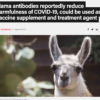Radial Immunodiffusion Plate Insert
INTENDED USE
The quantitation of serum proteins as an aid in diagnosing deficiency disorders.
SUMMARY
Single radial immunodiffusion tests have evolved from the work of Fahey and McKelvey1 and Mancini et al2. They are specific for the various proteins in serum or other fluids and depend on the reaction of each protein with its specific antibody.
When the wells in antibody containing gels are completely filled with the antigen, the precipitin rings which develop after 10-20 hours at room temperature are measured. The diameter of the ring and the logarithm (base 10) of the protein concentration are related in a linear fashion. Using appropriate reference standards, the concentration of unknown samples may be measured.
PRINCIPLE
Radial immunodiffusion is based on the diffusion of antigen from a circular well radial into a homogeneous gel containing specific antiserum for each particular antigen. A circle of precipitated antigen and antibody forms, and continues to grow until equilibrium is reached. The diameters of the rings are a function of antigen concentration. After overnight incubation, the zone diameters of reference sera are plotted against the logarithm (base 10) of the antigen concentration. If equilibrium is reached, the reference sera zone diameters are squared and plotted against their concentration (linear). At intervals in between, a linear relationship does not occur. Unknown concentrations are measured by reference to the standard curve.
REAGENTS
Radial immunodiffusion plates contain specific antiserum in agarose gel, 0.1M phosphate buffer, pH 7.0, 0.1% sodium azide as bacteriostatic agent, 1ug/ml amphotericin B as an antifungal agent. Plates also contain 0.002M Ethylenediaminetetraacetic acid. Store at refrigerator temperatures. (20 to 8o C).
Human Reference Sera – (Pooled human serum at three levels*). Contains sodium azide (0.1%) as bacteriostatic agent. Store at refrigerator temperature (not provided in orders of plates.)
Each human serum contained in the reference standards has been tested for hepatitis associated antigen (Hb) and found nonreactive. However a negative test does not eliminate the possibility that the causative agent may be present, and the sera should be considered infectious.
FOR IN VITRO DIAGNOSTIC USE
SPECIMEN & PREPARATION HANDLING
Collect whole blood without anticoagulant and allow to clot at room temperature.
Separate serum by centrifugation at about 200 rcf within 2-3 hours after collection.
Plasma may be used, but non-specific, precipitation of fibrin may obscure precipitation rings. In addition, liquid anticoagulents such as ACD fluid will dilute the specimen
CAUTION: As noted above, 3B - the unknown specimens should be treated as infectious.
PROCEDURE
A. Materials Provided
Three 24 (3x8) well radial immunodiffusion plates.
Human Reference Sera: 3 x 0.2ml vials(in kits only).
Directions for use.
B. Materials Required
Blood collection tubes
Centrifuge (200rcf)
Microliter dispenser (5 microliters) - available separately
Reference sera (required if not provided in kit form)
Measuring device - calibrated in 0.1mm increments – available separately.
Two cycle semi-logarithmic graph paper or linear graph paper.
C. General
Do not overfill or underfill wells. An improperly filled well yields erroneous results and the same specimen should be placed in another well. Overfilling with a 5 microliter sample indicates that some gel shrinkage has occurred.
Reference serum zone diameters should be measured at the same time as test sera. If a delay in measurement is anticipated allow sufficient intervals between filling wells.
The time of filling each plate should be marked on the cover and if more than one plate is filled, they should be read in order of filling.
Excess moisture is required to prevent drying. Replace each plate in its plastic bag and reseal carefully before incubation.
Shrinkage of gel or oval shaped wells indicate drying and the plate should not be used.
If temperature fluctuations are anticipated, the plates in their bags may be incubated in an insulated container. Fluctuations in temperature may result in multiple precipitin ring formation.
Unused sections may be run at a later date if the plate has been stored at 20 to 8o C between incubations in its plastic bag. Check carefully for evidence of drying and include new standards.
Rough granulation of the gel indicates freezing, plates should be discarded.
D. Performance of Test
Remove plates from refrigerator to room temperature approximately 30 minutes before filling wells. Do not open bag until ready for use.
If excess moisture is present, remove plate from its bag and remove cover until evaporation has dried the surface and wells. Replace cover until used.
For best results, three wells should be filled with reference sera for each plate. Location of each should be noted. Mix each vial of reference serum thoroughly.
Deliver specimen to well by placing the pipette tip at the bottom of the well. Allow the well to fill to the top of the agar surface. Avoid bubbles to ensure proper volume and diffusion of sample. Visualization may be aided by placing the plate on dark background. If practice is required, a used plate may be utilized.
More consistent results may be obtained when wells are filled with a 5 microliter pipette.
Mark time of completion on plate cover and replace cover.
Replace plate in bag and reseal carefully.
Incubate plates upright on a flat surface at room temperature (200 to 24o C) for 16-20 hours. Overnight readings and over 48 hours for End Point readings. See C6 above.
Measure diameters of precipitin zones to within 0.1mm. Variations in incubation times of more than 30 minutes will produce changes in diameters, especially those at higher levels of antigen except when plates have reached endpoint.
E. Calibration
Using the reference sera provided in kits, or other, such as the College of American Pathologists reference standard, determine their ring diameters to the nearest 0.1mm.
Using 2 or 3 cycle semi-logarithmic graph paper plot the concentration on the Y axis and the zone diameters on the X axis for each protein for Overnight readings.
Using regular graph paper plot the concentration on the X axis and the zone diameters squared on the Y axis for each protein for End point readings.(see Figure 2.)
Draw a straight line of "best fit" between the three points. A curved line usually indicates that the incubation time and/or temperature should be reduced. For valid results, a smooth curve should be fitted to the points and control sera included for additional verification.,
F. Quality Control
For consistent results and a comparison of lot to lot, day to day, and week to week variations, a "normal" and abnormal serum should be included each day. The diameters and concentrations obtained can be charted to determine means and standard deviations. For the same specimen, an appropriate series of wells on the same plate should yield diameters within 0.2mm of one another. Control sera should be freshly thawed or reconstituted.
G. Reference Sera
All reference sera supplied have been calibrated from Kent Standard sera and where applicable, the College of American Pathologist reference standard.
RESULTS
Determine the concentration of each unknown or specimen protein by reading its zone diameter on the reference curve and the corresponding concentration. Zone diameter must be squared for End Point calibration.
INTERPRETATION OF RESULTS & LIMITATIONS OF PROCEDURE
When an unknown diameter exceeds that of the top standard, the specimen should be diluted with saline and rerun.
When an unknown diameter is smaller than that of the lowest standard, its concentration should be reported as "less than" the concentration of the reference serum. If available, "low level" radial immunodiffusion plates may be utilized.
Lack of a precipitin ring may be due to :
Sample not applied to well.
A concentration too low to be detected by the method.
A concentration too high, resulting in the formation of soluble complexes, which are not precipitated.
EXPECTED VALUES
Determination of normal ranges has been established by analysis of serum from random blood donors, all of whom were 18-50 years of age. Variables such as sex, age, race, were not studied. Significant skewness occurs especially at higher levels and with increasing age. Other unknown variables may also affect each laboratory’s results. The range is listed as comprising 10 - 90% of the ranked population.



